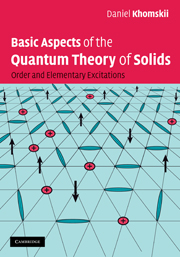Book contents
- Frontmatter
- Contents
- Foreword and general introduction
- 1 Some basic notions of classical and quantum statistical physics
- 2 General theory of phase transitions
- 3 Bose and Fermi statistics
- 4 Phonons in crystals
- 5 General Bose systems; Bose condensation
- 6 Magnetism
- 7 Electrons in metals
- 8 Interacting electrons. Green functions and Feynman diagrams (methods of field theory in many-particle physics)
- 9 Electrons with Coulomb interaction
- 10 Fermi-liquid theory and its possible generalizations
- 11 Instabilities and phase transitions in electronic systems
- 12 Strongly correlated electrons
- 13 Magnetic impurities in metals, Kondo effect, heavy fermions and mixed valence
- Bibliography
- Index
13 - Magnetic impurities in metals, Kondo effect, heavy fermions and mixed valence
Published online by Cambridge University Press: 05 June 2012
- Frontmatter
- Contents
- Foreword and general introduction
- 1 Some basic notions of classical and quantum statistical physics
- 2 General theory of phase transitions
- 3 Bose and Fermi statistics
- 4 Phonons in crystals
- 5 General Bose systems; Bose condensation
- 6 Magnetism
- 7 Electrons in metals
- 8 Interacting electrons. Green functions and Feynman diagrams (methods of field theory in many-particle physics)
- 9 Electrons with Coulomb interaction
- 10 Fermi-liquid theory and its possible generalizations
- 11 Instabilities and phase transitions in electronic systems
- 12 Strongly correlated electrons
- 13 Magnetic impurities in metals, Kondo effect, heavy fermions and mixed valence
- Bibliography
- Index
Summary
In the previous chapter we have considered the properties of strongly correlated electrons. The systems we mostly had in mind were the compounds of transition metal and maybe rare earth elements with partially filled inner d or f shells. We have discussed only the correlated electrons themselves, the prototype model being the Hubbard model (12.1).
When turning to real materials, several extra factors missing in the model (12.1) are important. One of them is the possible influence of orbital degrees of freedom, especially in cases with orbital degeneracy, treated in Section 12.9.
In many situations there is yet another very important factor. There may exist in a system, besides correlated electrons, also electrons of other bands, e.g. electrons in wide conduction bands, responsible for ordinary metallic conductivity. Such is for instance the situation for magnetic impurities in metals, or in the concentrated systems like rare earth metals and compounds in which localized f electrons coexist with the metallic electrons in broad spd bands. The interplay between localized, or, better, strongly correlated electrons and itinerant electrons of the wide bands can lead to a number of very interesting consequences; these will be discussed in this chapter.
Localized magnetic moments in metals
When we put transition metal impurities in ordinary metals (e.g. Mn or Fe in Cu, Au), the result may be two-fold. In certain cases the impurities retain their magnetic moment, but in others they lose it.
- Type
- Chapter
- Information
- Basic Aspects of the Quantum Theory of SolidsOrder and Elementary Excitations, pp. 272 - 295Publisher: Cambridge University PressPrint publication year: 2010



